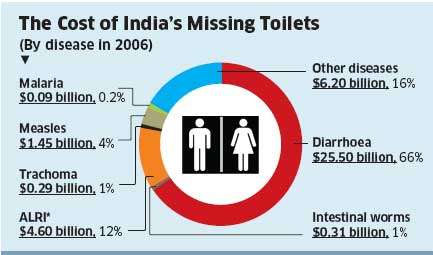Published on: 27/03/2012

A model where public funds provide the back-end and private funds provide the front-end can fill the gap in sanitation financing in India, writes Anupam Tyagi from the International Management Institute in the Economic Times of February 9th, 2012.
According to a recent report by Water and Sanitation Program (WSP), the lack of adequate sanitation in India resulted in an annual loss of $53.8 billion ($161 billion in purchasing power parity, or PPP) or $48 per capita ($144 in PPP) in 2006, the year of evaluation in the report. This was equivalent to 6.4% of GDP in 2006.
Most of these losses were related to health (71.7%; $38.5 billion), and mostly concentrated in children below five years. Other quantified economic losses relate to getting access to cleaner drinking water, time losses from not having access to sanitation, and tourism-related losses.
Based on international evidence, even locally-implemented toilet and hygiene interventions could have saved $32.6 billion, equivalent to 3.9% of GDP annually; a potential gain of $29 per capita.
If the 2020 goals for sanitation stated by government are achieved (household and community toilets, sewage treatment infrastructure, and operations and maintenance), the annual national toilet and sewage treatment market is estimated at over $6.6 billion annually, with cumulative market during 2007-20 at over $152 billion.
Of the cumulative market, $97 billion, or 64%, can potentially be in infrastructure and $54 billion, or 36%, in operations and maintenance services. In this context, it is clear that government funds allocated to sanitation fall far short of the finances needed to achieve goals stated in government documents.
Filing the gap in sanitation financing
One way is to fund the gap in financing of sanitation infrastructure is to find funds in government plan and Budget allocations, the other is to look for public and private financing, including public and private international funds. These are complementary and non-competing sources.
A model where public funds provide the back-end and private funds provide the front-end can fill the gap in sanitation financing. This G-B-C, or Government-Business-Consumer, model can be used at all levels of government, by including local governments.
This may include plan and budgetary funds, state funds, municipal and local government funds, and private funds to build sewers and sewage treatment infrastructure of high quality. This may be done on a build-operate-transfer (BOT) basis, or on a lease-hire-to-businesses basis - like telecom, electricity or transport infrastructure in some places.
Business operators could raise their own finances to deliver services, and government and democratic institutions can play a regulatory role to ensure these 'natural' monopolies provide good service at reasonable price to consumers. These businesses may also help households find long-term financing for access to toilets and sustainable sewage treatment systems that have long durability and high quality.
Read the full article by Anupam Tyagi, Economic Times, 9 Feb 2012 (below)
At IRC we have strong opinions and we value honest and frank discussion, so you won't be surprised to hear that not all the opinions on this site represent our official policy.